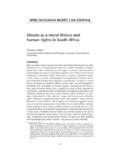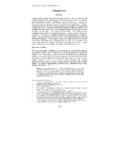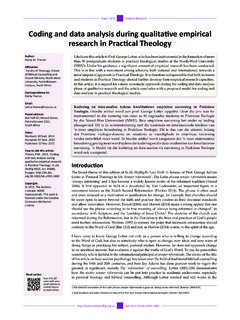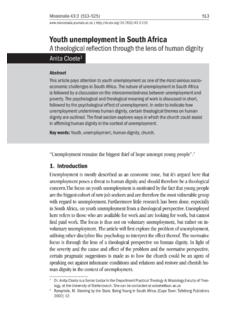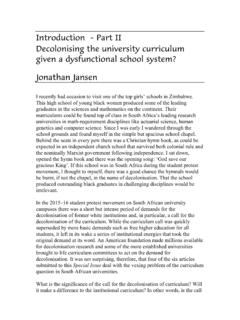Transcription of Karl Barth's understanding of mission: The Church in ...
1 karl barth s understanding of mission: The Church in relationship1W Bentley2(University of Pretoria) ABSTRACT karl barth s understanding of mission: The Church in relationship As the Church is moving towards its 21st century of existence, it is confronted by challenges it has never known before. This changing world demands self-reflection within the Church . It has to consider its place, identity and function, thereby giving rise to the exploration of its mission. In this article, the ecclesiology of karl barth is explored.
2 By considering barth s understanding of the Church s relationship with different parties such as God, other religions, those outside the Christian faith, the State and its own inner dynamics, the Church will be reminded of its missionary function in the world. 1 INTRODUCTION Is the Church s missional function still valid in a world that is faced with ever increasing challenges? It seems that a world governed by modernist principles and challenged by post-modern philosophies, necessitates the need for the Church to think creatively about its mission.
3 barth s description of the Church s mission provides a good model that would facilitate such a process. This model focuses on the Church s relationships and defines mission accordingly. Before discussing barth s definition of the Church as it exists in relationship with the different entities, attention needs to be given to barth s description of the mission of the Church as found in Church Dogmatics. 2 THE MISSION AND FUNCTION OF THE Church barth starts by defining the Mission and Function of the Church in Church Dogmatics Volume 1 ( barth 1956a:743-884) by describing 1 This article is based on research done for a PhD degree in the Department of Dogmatics and Christian Ethics of the Faculty of Theology at the University of Pretoria.
4 The supervisor is Prof CJ Wethmar. 2 Dr Wessel Bentley is a part-time lecturer in the Department of Systematic Theology and Theological Ethics at the University of South Africa. ISSN 1609-9982 = VERBUM ET ECCLESIA JRG 30(1)2009 25 the relationship between God s self-revelation and the Church s ability to engage with the revealed Word. This teaching on the Church s Mission and Function follows on from his Doctrine of Revelation ( barth 1956a:1-456) and the Doctrine of Holy Scripture ( barth 1956a:457-742).
5 It is evident in the progression found in Church Dogmatics Volume 1, Part 2 that the Church s identity is founded on the premise that it exists as a response to the work that God has done. God reveals Godself, and so the revelation is received and appreciated by humanity in and through the power of the Spirit and, as a result, a community is established that continues the witness of those who have testified to God s self revelation as attested in Holy Scripture. The crucial question remains: If the Church is a testifying response to the revelation of God, how do we understand the mission of the Church in the light of its testimony?
6 In order to address this question, a summary of barth s position on the Church s function and mission is now given. The mission of the Church barth (1956a:743) describes the Church s mission as proclamation . In this section of Church Dogmatics, barth (1956a:743-797) does not explore the nature of the Church s missionary proclamation in the different relational contexts, but describes the fundamental tensions that exist in the Church s role. The first tension barth points to, is the Church s recognition that there is a distinct difference between what he calls The Word of God and the Word of Man (1956a:743).
7 By this is meant that when the Church engages in the practice of proclamation, it has to contend with the problem that its proclamation serves as a secondary process of communication that is subject to the initial act of God s self-disclosure. This leads barth (1956a:743) to ask the following questions: Is the Church s preaching also God s Word, and to what extent? Is God s Word also the preaching of the Church , and, if so, is it valid? With the distinction made between the Word of God and the Word of Man [sic], the Church s proclamation can only be the Word of God in that it is a testimony about the Word, concerning the self-revelation of God in God s Word.
8 The testimony of the Church is therefore imperfect, because it is a proclamation based on the receipt and interpretation of revelation. Would it then not be better for God to rely upon God s own revelation in the proclamation of the 26 karl barth S understanding Word? To barth (1956a:745-755), God must be aware of this fundamental flaw in the Church s proclamation, but God must also resign Godself to the fact that this flawed testimony is the basis on which the Church communicates its understanding of, and relationship with God to the world.
9 Revelation and proclamation are both therefore dependent on God s grace, for the Church (which consists of people) is confronted by the self-disclosure of a God who is beyond all creation s limitations. The Church is, at the same time, charged to testify in human language, symbolism and rituals, of a God who it cannot define empirically nor contain within the parameters of human communication. The Church must therefore make certain admissions. The first is that the revelation of God is already complete outside its proclamation ( barth 1956a:749).
10 God s self-disclosure is therefore not solely dependant on the Church s testimony, but is itself a proclamation before the Church can respond with its own testimony. This, to barth (1956a:749), has already been achieved in Jesus Christ. The second is the recognition that it is humanly impossible to speak about God using human language, reasoning and symbols ( barth 1956a:750). The Church s testimony cannot be engaged in the practise of defining God. Had it been tempted to limit the person of God to the expression of its own interpretation, the Church would be treating God as an object.
